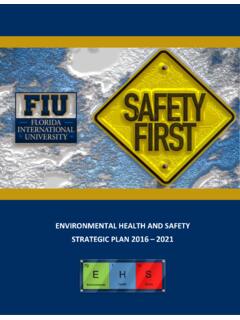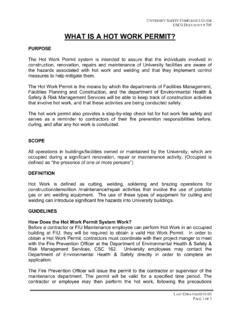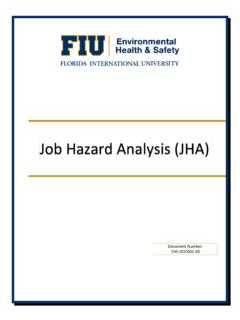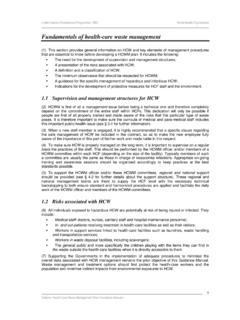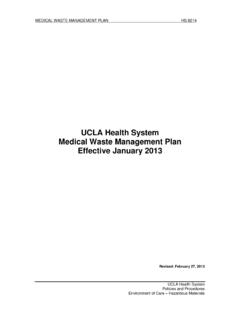Transcription of Guidelines For The Safe Use Of Laboratory Fume Hoods
1 (305) 348-2621 Revision Date: 5/30/2019 Page 1 of 2 Guidelines For The Safe Use Of Laboratory fume Hoods The level of protection provided by a fume hood is affected by the manner in which it is used. No fume hood , however well designed, can provide adequate containment unless good Laboratory practices are used. Adequate planning and preparation is the key. The hood user should know the Standard Operating Procedures (SOP) of the hood and should design experiments so that the SOP can be maintained whenever hazardous materials might be released. Items contaminated with odorous or hazardous materials should be removed from the hood only after decontamination of it, if placed in a closed outer container, to avoid releasing contaminants into the Laboratory air. The following work practices are to be followed when hazardous materials, equipment and operations are being used inside Laboratory fume Hoods .
2 All operations that may generate hazardous air contaminants must be done inside a Laboratory fume hood . fume Hoods do not prevent accidents or chemical splashes. hood users must be trained in the proper operation and use of Laboratory fume Hoods . The hood should not be operated unless it is verified that it is working correctly. Safety glasses (goggles), lab coats, and appropriate chemical gloves must be worn when working in, on, or around the fume hood . Do not put your head in the hood , beyond the sash opening. Do not use the hood for storage of equipment, containers, or chemicals which are not going to be used during the day. Equipment and materials placed in the hood must not block hood slots, airfoils, or otherwise interfere with the smooth flow of air into the hood . Never place or use equipment that protrudes beyond the face of the hood (sash opening).
3 This configuration will disrupt air flow of air into the hood and reduce its efficiency. Keep all equipment and materials at least 6 inches behind the plane of the sash ( hood face), this will improve containment capture. A stripe (tape) on the hood working surface is a good reminder. Place all bulky equipment away from the sidewalls to allow air flow around the equipment. Place any bulky equipment towards the rear of the hood and raise it above 1 inch above the working surface with blocks to allow air flow under and around the equipment. Do not use the hood as a waste disposal mechanism of volatile materials. For clarification contact EH&S (ext. 72621). Flammable liquids must not be stored permanently in the hood or cabinet(s) under the hood unless that cabinet(s) meets the requirements of NFPA 30 & 45 for flammable liquid storage. For clarification, call EH&S.
4 (305) 348-2621 Revision Date: 5/30/2019 Page 2 of 2 The only chemicals that should be in the hood are those that are contained in experimental equipment and portable containers which are to be used that day. All portable chemical containers must be removed from the hood when not being used and at the end of the working day. Caps on the bottles of chemicals being used in the fume hood should be tightly closed when not in use. Substitute with less hazardous or less volatile chemicals where possible. Do not place any heat generating equipment in the rear of the hood . Heating devices in the hood produce convection currents that can disrupt air flow. Do not place electrical receptacles or other spark sources inside the hood when flammable liquids or gases are present. No permanent electrical receptacles are permitted in the hood . Do not place objects or equipment in front of the hood which can interfere with air flow patterns into the hood reducing its effectiveness.
5 Use appropriate barricades in front of the hood if there is a chance of explosion or eruption. While working inside the hood keep the hood sash closed as much as possible while still allowing comfortable working conditions (never more than 18 ). Do not remove hood sash or panels except when necessary for apparatus set- up or removal. If the hood sash is supposed to be partially closed for the operation, the hood should be so labeled and the appropriate closure point clearly indicated. Completely close the hood sash or panels: i. At the end of the day. ii. When leaving experiments or chemicals unattended. iii. When the hood is not in use. Do not: i. Make quick motions into or out of the hood . ii. Use fans near, or walk quickly by the hood opening. These conditions will cause airflow disturbances which reduce the effectiveness of the fume hood .
6 Pedestrian traffic must be restricted near operating fume Hoods . Keep Laboratory doors and windows closed to ensure negative room pressure to the corridor and proper air flow into the hood . Do not attempt to override or disable hood face velocity monitors/alarms. If a problem with the device occurs contact Facilities Management at ext. 74600 for assistance. The hood must not be operated without the back baffles in place. If you have any questions, please contact FIU EH&S at (305) 348-2621 or
